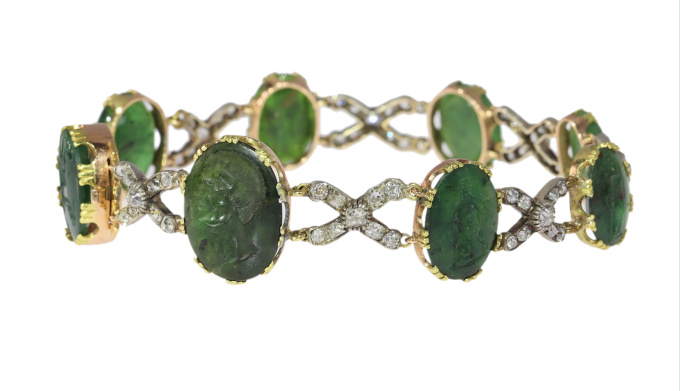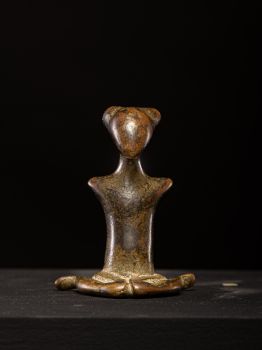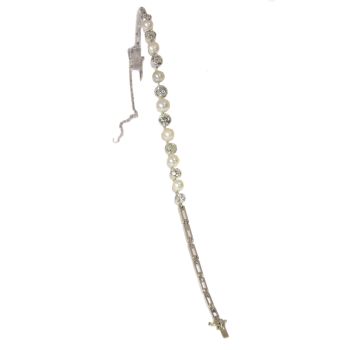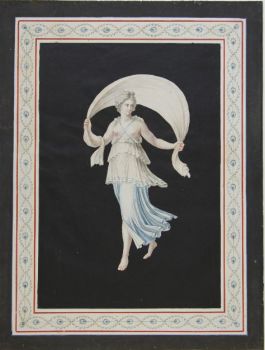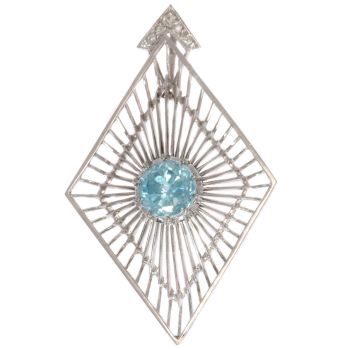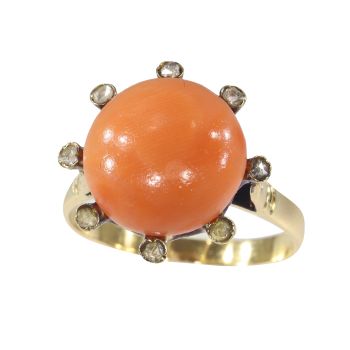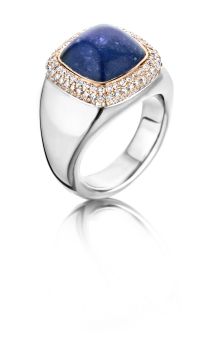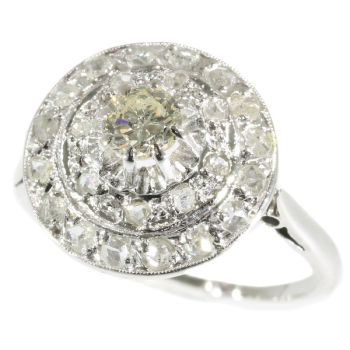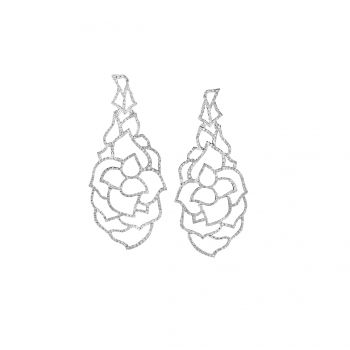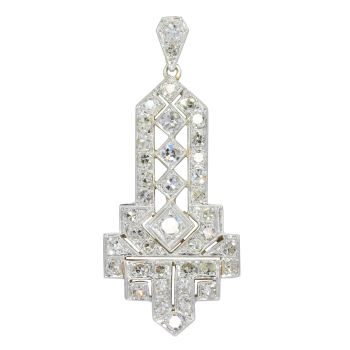18e-eeuwse diamanten armband met 2000 jaar oude Romeinse intaglio's 1790
Onbekende Kunstenaar
DiamantIntaglioChalcedoonEdelsteen
1 ⨯ 18 cm
€ 23.000
Adin Fine Antique Jewellery
- Over kunstwerk
We could have never imagined how much history and exact data is concealed in this late 18th Centurybracelet with chromium chalcedony intaglios dating back from between 100 BC until 100 AD set in 14K bi-colour gold alternating with silver-encrusted old mine brilliant cut diamonds.
One interesting fact we already want to point out to you is that one intaglio is the same type as the one of Julius Caesar's own signet ring, inherited and worn by Augustus.
We invite you on this journey back in time, but be warned: you have to appeal on your stamina.Antique jewelry object group: bracelet
Condition: excellent condition, especially given its age (one of the intaglio's has a chip at the back, not visible from above)
- (more info on our condition scale)
Country of origin: The origin of the bracelet itself is unknown.
The chromium chalcedony, in which the intaglios have been carved, originates from a single source nearEskisehir/Anatolia (Turkey). Furthermore, the carving of the chromian chalcedonies has been done in Italy. For more information, we invite you to the elucidation below, provided by Hadrien Rambach, expert i.a. cameos.
Style: Neo Classical (somewhere between Louis XVI and Empire)
This (second) neoclassic wave, more severe, more studied and more consciously archaeological, is associated with theheight of the Napoleonic Empire. In France, the first phase of neoclassicism was expressed in the "Louis XVI style", and the second in the styles called "Directoire" or Empire.
The Empire style, sometimes considered the second phase of Neoclassicism, is an early-19th-century design movement in architecture, furniture, other decorative arts, and the visual arts followed in Europe and America up to around 1830. Thestyle originated in and takes its name from the period when Napoleon I ruled France, known as the First French Empire, where it was intended to idealize Napoleon's leadership and the French state. The style corresponds to the Biedermeier style in theGerman-speaking lands, Federal style in the United States and to the Regency style in Britain. An earlier phase of the style was called the Adam style in Great Britain and "Louis Seize" or Louis XVI, in France.
- See also: Empireor more info on styles
Style specifics: A typical element for jewellery from the Louis XVI period are the X-shaped links in between the intaglios and the old mine brilliant cut of the diamonds. Typical as well for the Empire style is the use of intaglios, which refers to the revival ofClassicism during that era.
Period: The bracelet itself has been crafted around 1790.
However, the chromium chalcedony intaglios can be dated between ca. 100 BC and 100 AD. For more information, weinvite you to the elucidation below, provided by Hadrien Rambach, expert i.a. cameos.
- (events & facts of this era, poetry of this era, fashion of this era)
Source of inspiration: Mythology
Material: 14K bi-color gold yellow and red (touchstone tested). The diamonds are set in silver (touchstone tested).
- (more info on precious metals)
Technique: Intaglio - An intaglio or engraved gem is a gem that has been carved, in the Western tradition normally with images or inscriptions only on one face. The engraving of gemstones was a major luxury art form in the ancient world, and an important one insome later periods. Strictly speaking, the term intaglio refers to cameos, carved gemstones, with the design cut into the flat background of the stone as opposed to relief carvings with the design projecting out of the background, as in nearly allcameos.
Diamond(s): 71 old brilliant cut diamonds with an estimated weight of ± 2.50ct. (colour and clarity: F/K, vs/i). The type of diamond cut here (old mine cut) is considered to be very rare for 18th Century jewellery. Most of the jewellery from 18th Century and older are rose cutdiamonds.
- All diamond weights, color grades and clarity are approximate since stones are not removed from their mounts to preserve the integrity of the setting. Also we have all diamonds screened by the IJGC - lab (www.ijgc-worldwide.com) for whether they are natural or synthetic, and all diamonds in this jewel are 100% guaranteed to be natural!
Precious stones: Eight chromium chalcedonies and the description of each of these Roman intaglios (directions left/right) is given according to the impressions that these seals would make in wax.
Nº 01 depicts: the bare head of a male to right, in a Late Republican fashion
Nº 02 depicts: Asklepios standing to left, draped, with his snake around his caduceus
Nº 03 depicts: a standing soldier to left, helmeted, holding spear and shield: Mars?
Nº 04 depicts: a Victory walking to right, holding a wreath and a palm
Nº 05 depicts: a standing female deity facing, resting on a short column, holding drapery and a palm with one arm, a spear and shield (?) with the other
Nº 06 depicts: a standing female deity to left, elegantly dressed, holding something in her her, with letters behind her.
Nº 07 depicts: Bacchus dancing (?), nude, holding a vase from which he verses wine towards the ground where a panther rests
Nº 08 depicts: Venus Victrix standing to right, resting on a short column, holding the spear and helmet. This type was the one of Julius Caesar's own signet ring, inherited and worn by Augustus. It can be found on several coins of the 1stand 2ndcentury AD. For otherexamples, in various stones, see Erika Zwierlein-Diehl (Die antiken Gemmen des kunsthistorischen Museums in Wien, vol. II, 1979, no. 1460-1476).
Venus Victrix (Venus the Victorious) was an aspect of the armed Aphrodite that Greeks had inherited from the East (the goddess Ishtar was a goddess of war). Venus Victrix was considered able to bring victory to warriors such as Caesar, and Pompeydedicated a temple to her - at the top of his theater in the Campus Martius in 55 BC. She also had a shrine on the Capitoline Hill. /// Les armes d'Énée, fabriquées par Vulcain (Virgil, Eneid, 8, 416-453) et que Vénusétait venue remettre à son fils (8, 608-625).
Birthstones: Diamond is the birthstone (or month stone) for April.
- (more info on birthstones)
Dimensions: Total length ca. 18,00 cm (7,09 inch) x max. width ca. 1,55 cm (0,61 inch) - See picture with a ruler in cm and inches
Weight: 10,50 gram (6,75 dwt)
Adin Reference Nº: 17010-0246Full description, provided by Hadrien Rambach:
Part one: On the origin of chromium chalcedony intaglios
This bracelet is set with intaglios cut into chromium chalcedony, a scarce material which has been proven by Cigdem Lule to originate from a single source near Eskisehir / Anatolia.
"A fashionable lady wears cameos at her girdle, cameos in her necklace, cameos on each of her bracelets, a cameo on her tiara. Antique stones are more fashionable than ever, but in default of them one may employ engraved stones" ( Journal des Dames, 25 Ventôse XIII (1806), quoted in O'Day1974, p. 15, and in Gere-Rudoe2010, pp. 467-468).
Typical 1st century AD gems, depicting a variety of gods and goddesses: Asklepios, Victory, Mars (?), Venus, Fortuna (?), etc, as well as an attractive male portrait in Late Republican style.
It is only recently that scientific attention has been paid to the materials used in ancient engraved gems, and over the past few years several articles have been devoted to those "green translucent stones": chromium chalcedonies (Maaskant1975, p. 168;Sax1996, pp. 63-72; Lüle2006; Platz2010; Lüle2011). As a general rule, "one cannot identify the vein from which the stones came-out. Ancient texts only, and the alchemist tradition of the Middle-Age, bring us some indication on their origins", (Guiraud1996, p. 30).
A study of the jewellery in which and with which chromian calcedonies have been found allowed Gertrud Platz to conclude that they "were distributed throughout the Roman Empire" but also that "one might assume that they were manufactured mainly in central Italy" (1).
The archaeological contexts in which they have been found indicate that the large majority of ancient engraved chromian calcedonies can be dated between the Julio-Claudian period (c.30 BC onwards) and the reign of Trajan (up to c.110 AD) (2).
Another - very small - group of chromian calcedonies were carved during the Antonines (c. AD 140-150), and a last one under the Severan dynasty (c. AD 195-230) (3).
But all the gems employed by Melillo belong to the first group, the later two being principally Imperial portraits. We can note here that two cameos only are known in chromian calcedony (4), that they both belong to the early range ofthe first period, and that they are both imperial portraits which confirms the preciousness of the material: a portrait of Livia formerly in the collection of Orsini (5), and a portrait of Claudius found in Pompeii in 1878 (6).
(1) Platz2010, p. 196.
(2) This starting-point is an approximate date that coincides with the extinction of the Hellenistic rule in Egypt (Cleopatra VII killed herself in 30 BC), and the beginning of the Roman Empire (Octavian becoming Augustus in 27 BC): two simultaneousevents that lead to a geographical displacement of many artists (including gem-engravers). Some gems were later remounted in more fashionable rings. For a chromian calcedony re-engraved in the early fourth-century AD, see Berlin 1969 no. 516 = Platz 2010 p. 190.
(3) Platz2010, pp. 187 and 192-195, who discusses whether there may be some 3rd-4th-century AD Christian chromian calcedonies.
(4) The gems Orsini1884 no. 64 = Naples1994 no. 73 andOrsini1884 no. 309 = Naples1994 no. 138 are miniature sculptures rather than cameos.
(5) Orsini1884, no. 356: "cameo di prasma con testa di Liuia moglie d'Augusto, col suo scattolino, dal medesimo - 5" .
(6) Naples1983 no. 182; Platzs2010, pp. 183 & 192.
Part two: On the occurence of green gems in ancient times
Green gems were much in favour in ancient times, which explains their predominance in some hoards (such as Eauze in Gaul) and some excavations (such as the area of the Vesuvius). Theophrastos and Pliny used the name smaragdus for twelve different stones (1): ancient writers in general did not distinguish the different varieties of green chalcedonies and beryls. Therefore, we still cannot be certain of the actual nature of the material in which the portraits of Alexander the Great (2) and Ptolemy SoterII (3) were engraved. Until now, the vocabulary of archaeologists and art-historians remains imprecise or mistaken: chromian chalcedonies are commonly called 'prases', from the Latin prasius (leek coloured), though they are usually deep and dark, or even 'plasmas' which is very erroneous as that is in fact green jasper (opaque).
It is attested that, at the time of Pliny who was writing in AD 77-79, the 'emeralds' (smaragdus) were the third most sought-after jewels, after diamonds and pearls. "Indeed there is no stone, the color of which is more delightful to the eye; for whereas the sight fixes itself with avidity upon the green grass and the foliage of the trees, we have all the more pleasure in looking upon the smaragdus, there being nogreen in existence of a more intense colour than this. And then, besides, of all the precious stones, this is the only one that feeds the sight without satiating it. […] Neither sunshine, shade, nor artificial light effects any change in theirappearance; they have always a softened and graduated brilliancy" (4).
For the Roman men and women, it was the colour of their gems that mattered, rather than their rarity: the stronger the colour, the better; and deep green gems were therefore of particular value (5).
One of the most serious academic researcher, H. Guiraud, specialised only in archeological finds, did not hesitate to write that "les intailles et les camées sont des objets d'art, si un grand artiste les a faits, si la matière est belle" (6) - i.e. "intaglios and cameos are works of art, if they were made by a great artist, if the material is attractive".
(1) Theophrastos, De Lapidibus, IV, 23-27; Platz2010, pp. 187-188.
(2) Pliny, Nat. Hist., 37, 8.
(3) Plutarch, Life of Lucullus, 3.1.
(4) Pliny, Nat.Hist , XXXVII.16. Pliny also comments: "Even when the vision has been fatigued with intently viewing other objects, it is refreshed by being turned upon this stone; and lapidaries know of nothing that is more gratefully soothing to the eyes, its soft green tints being wonderfully adapted forassuaging lassitude, when felt in those organs"; see Krug1987and Woods2006 about whether Nero could have actually used an emerald to look through.
(5) Interestingly, the many glass-gems that survive often copy hardstones (brown sards, orange carnelians, black and blue nicolos, multi-coloured banded agates), but we only know few pastes trying to look-alike chromian calcedony (e.g. Fossing1929,no. 709, Vitellozzi 2010no. 216). Pliny's warning, that crystal can be coloured like emeralds, refers to rock-crystal rather than to glass (Nat. Hist., XXXVII, 79 & 197). On an actual example of ancient hardstone-colouring (of nicolos), see Revel1992, p. 354.
(6) Guiraud 1996, p. 9.
Biblio.:
Lüle 2006 Çigdem Lüle-Whipp, "Chromium Chalcedony from Turkey and its possible archaeological connections. Gemological research conference", Gems & Gemology, vol. XLII (Fall 2006), p. 115
Lüle 2010 Çigdem Lüle, "Archaeogemology", The Gem Guide, issue 29.3 (May-June 2010), pp. 1, 4-6, 14
Lüle 2011 Çigdem Lüle, "Non-destructive gemological tests for the identification of ancient gems", in Chris Entwistle and Noël Adams (ed.), 'Gems of Heaven'. Recent research on Engraved Gemstones in Late Antiquity c. AD 200-600, British Museum Research Publication number 177 (2011), pp. 1-3.
Platz 2010 Gertrud Platz-Horster, "Kleine Praser and Chromium-bearing Chalcedonies. About a small group of engraved gems", PALLAS, vol. 83 (2010), pp. 179-202
Copyright photography: Adin, fine antique jewellery
latest acquisitions,
antique jewelry, estate jewelry, vintage jewelry or modern jewelryJewelry with birthstones (or month stones) for:
January - February - March - April - May - June - July
August - September - October - November or December.
Additional information:
jewelry glossary - wall of fame - visit us in Antwerp - subscribe to our mailinglist.
What is antique jewelry? - What is estate jewelry? - What is vintage jewelry? - Over kunstenaar
Het kan voorkomen dat een kunstenaar of maker onbekend is.
Voor sommige werken is het niet te bepalen door wie het gemaakt is of dat het is gemaakt door (een groep) ambachtslieden. Voorbeelden zijn beelden uit de Oudheid, meubels, spiegels of handtekeningen die vaak niet duidelijk of leesbaar zijn. Maar ook sommige werken zijn helemaal niet gesigneerd.
Ook kunt u de volgende beschrijving vinden:
•"Toegeschreven aan …." waarschijnlijk een werk van de kunstenaar maar niet zeker of gedeeltelijk
•“Atelier van ….” of werkplaats van” een werk uitgevoerd in het atelier of atelier van de kunstenaar, eventueel onder zijn toezicht
•“Cirkel van ….” een werk uit de periode van de kunstenaar die zijn invloed laat zien, nauw verbonden met de kunstenaar maar niet noodzakelijkerwijs zijn leerling
•“Stijl van ….” of “Volger van ….” een werk uitgevoerd in de stijl van de kunstenaar, maar niet noodzakelijk door een leerling; kan eigentijds of bijna eigentijds zijn
•“Wijze van ….” een werk in de stijl van de kunstenaar maar van latere datum
•"Na …." een kopie (van welke datum dan ook) van een werk van de kunstenaar
•“Getekend…”, “Gedateerd….” of “Ingeschreven” dan is het werk gesigneerd/ gedateerd/ ingeschreven door de kunstenaar. De toevoeging van een vraagteken duidt op een element van twijfel
•"Met handtekening ...", "Met datum ...", "Met opschrift..." of “Draagt signatuur/datum/opschrift” dan is de handtekening/datum/opschrift toegevoegd door iemand anders dan de kunstenaar
Bent u geïnteresseerd om dit kunstwerk te kopen?
Artwork details
Related artworks
- 1 - 4 / 12
Lawrence Alma-Tadema
"Caracalla and Geta: Bear Fight in The Coliseum, AD 203" 1907
Preço em pedidoGallerease Selected
 Com curadoria de
Com curadoria deDanny Bree
Lawrence Alma-Tadema
"Caracalla and Geta: Bear Fight in The Coliseum, AD 203" 1907
Preço em pedidoGallerease Selected
 Com curadoria de
Com curadoria deDanny Bree
1 - 4 / 24- 1 - 4 / 24
Artista Desconhecido
Conjunto de oito desenhos a guache1799 - 1801
Preço em pedidoRobert Schreuder Antiquair
1 - 4 / 24- 1 - 4 / 24
- 1 - 4 / 12







